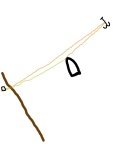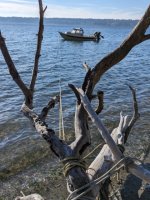Salish_Explorer
New member
Hello, just wanted to share a technique that I used the other day with significant success (more on that in a minute), which I think solves two dilemmas often faced by Dory people: swing and shore accessibility.
I inadvertently tested this out in a ~20mph onshore winds overnight and it worked really well. Video link here: https://photos.app.goo.gl/g9UrvCcsSsTzJnid6
Caveat: This technique is new to me, and I don't see it mentioned prominently on the forums, I'm sure others* have used something like it. There's nothing truly "new" under the sun!
Basically the technique is this: Set an anchor offshore before beaching, then use it to haul your vessel back offshore after, but trailing a bow line, so that you end up in a zero-swing double moor.
I've attached a basic diagram, and will drop the steps in a comment.
The difference between this and a standard shore tie is the ground tackle, and the fact that you are able to bring your boat back off the beach.
Sailors or those with more anchoring experience will recognize this as a modified Bahamian Moor.

*I believe that Marco Flamingo has used a similar technique except with an elasticized section of rode, which 'springs' his boat back off the shore.
I inadvertently tested this out in a ~20mph onshore winds overnight and it worked really well. Video link here: https://photos.app.goo.gl/g9UrvCcsSsTzJnid6
Caveat: This technique is new to me, and I don't see it mentioned prominently on the forums, I'm sure others* have used something like it. There's nothing truly "new" under the sun!
Basically the technique is this: Set an anchor offshore before beaching, then use it to haul your vessel back offshore after, but trailing a bow line, so that you end up in a zero-swing double moor.
I've attached a basic diagram, and will drop the steps in a comment.
The difference between this and a standard shore tie is the ground tackle, and the fact that you are able to bring your boat back off the beach.
Sailors or those with more anchoring experience will recognize this as a modified Bahamian Moor.

*I believe that Marco Flamingo has used a similar technique except with an elasticized section of rode, which 'springs' his boat back off the shore.

